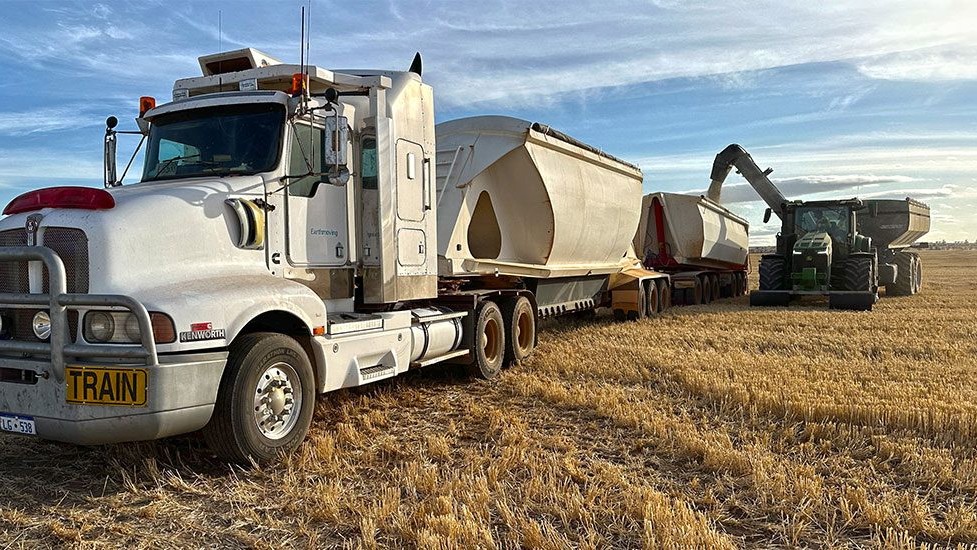The Western Australian grain harvest

The grain harvest in Western Australia is quite an undertaking each year, with an average 18 million tonnes produced by 4000 rain-fed farms. Between 2022 and 2023, a record crop of 24 million tonnes of grain was trucked to bulk handling bins throughout the southwestern part of the state.
All this activity takes place in a tight timeframe. It starts in the last week of October and almost all of it is done by the end of December – the 2023 season being unusual in that many farmers started cropping in late October and were finished by early December. Australia expects to account for 13.7% of the world’s wheat exports in 2023, and Western Australia accounts for 40% of that.
The reason for Western Australia’s success as a grain producer is the region’s mostly predictable weather pattern, which enables the farmers to plan their planting with white-grained wheat varieties that generate high yields for flour milling that is suitable for a range of products. This is unlike the Eastern states, which have rather more unpredictable weather patterns, making it harder for the farmers to plan their planting.


The fleet of trucks involved in moving these massive amounts of grain come from specialised fleets that do nothing but cart grain, fertiliser and sand to little one-man outfits and then, of course, the farmers themselves, who do a lot of their own cartage. The trucks vary in size and shape, from single-steer, tandem-drive and twin-axle tippers to C-trains that have a B-train A trailer (usually a tri-axle set-up) with two tri-axle tippers behind, with a tri-axle dolly between the second and third trailer.
These modern tipping trailers are usually fitted with self-weighing scales to maximise axle and gross vehicle mass loadings.
The harvest cycle starts with the farmer getting the header, chaser bin and tractor out of the shed, as well as any trucks that he or she may have. Some of them have some quite nice rigs but a lot of them are old, retired equipment from the transport industry, some of which have seen better days. Once the crop is cut, the header (combined harvester to some people) keeps cutting until the crop bin is full, the chaser bin driver should have the chaser alongside the header to receive the crop. The chaser bin driver takes the chaser to the truck waiting on the farm roadway and loads whatever amount of grain the truck can legally take.
These chaser bins are modern technology and farm machinery married together to make accurate loading of the trucks quite easy. The bulk bin will reject the load if the truck exceeds its legal weight by more than 10%. In such cases, the truck must return to the farm to offload the excess before the driver can bring it back to the bin. The grain is then sampled and graded to determine its appropriate classification. A hydraulic arm does the sampling with a vacuum probe that is forced down into the load of grain four or five times per trailer load to get a good overall sample.


From the sample hut, the truck goes to the weighbridge to be gross weighed. The truck then proceeds to the grid it has been allocated for that particular type and grade of grain. Once the grain is tipped, it is back to the weighbridge – tare out, get the net weight for the load and back to the farm for the next load.
Wheat tends to be the main crop, with Western Australia producing 40% of Australia’s crop. Some 95% of this is exported to Asia and the Middle East. China alone took 6.4 million tonnes of Australian wheat in the 2022-2023 season.
While wheat is the bulk of Western Australia’s grain, it is not alone in earning the state a healthy export cheque each year. Barley, canola, oats, lupins and field peas do their bit as well. Moreover, the state exports thousands of tonnes of hay and animal feed each year. Around the Lake Grace area, barley was the bulk of the crop last year, but it varies from area to area and year to year, depending a lot on what commodity prices are doing.
Once the harvest is over each year, and this huge amount of grain is stored, it is time to think about getting it to the major grain handling facilities in Perth, Albany, Bunbury, Esperance and Geraldton. The bulk of this is taken care of by Combined Bulk Handlers’ (CBH) trains that run on mainly dedicated train lines, but some of it goes on general freight lines. The rest of it – and it is still in the millions of tonnes – goes by road. This keeps those specialised fleets and their subcontractors busy for the rest of the year, carting grain from the smaller regional bins with no rail connection to the larger regional bins that do have rail connection.

If the amount of grain to be moved from the larger bins to the port facilities is too much for the rail network, the trucks get called in to do what is known as bin transfers. If the export orders are large enough, companies can be tied up doing bin transfers for months at a time out of one major regional bin.
Once all the crop is in, the trucks then start the bin transfers. The trucks not doing bin transfers will then turn their attention to transporting fertiliser and sand from the quarries and the fertiliser plants to the farms. A lot of farmers put sand on their paddocks as well as fertiliser to get soil balance – this keeps the rest of the fleet busy for the remainder of the year.



Read more
The sale is on!
0 Comments7 Minutes
Running north
0 Comments13 Minutes
Changing the Game
0 Comments10 Minutes





